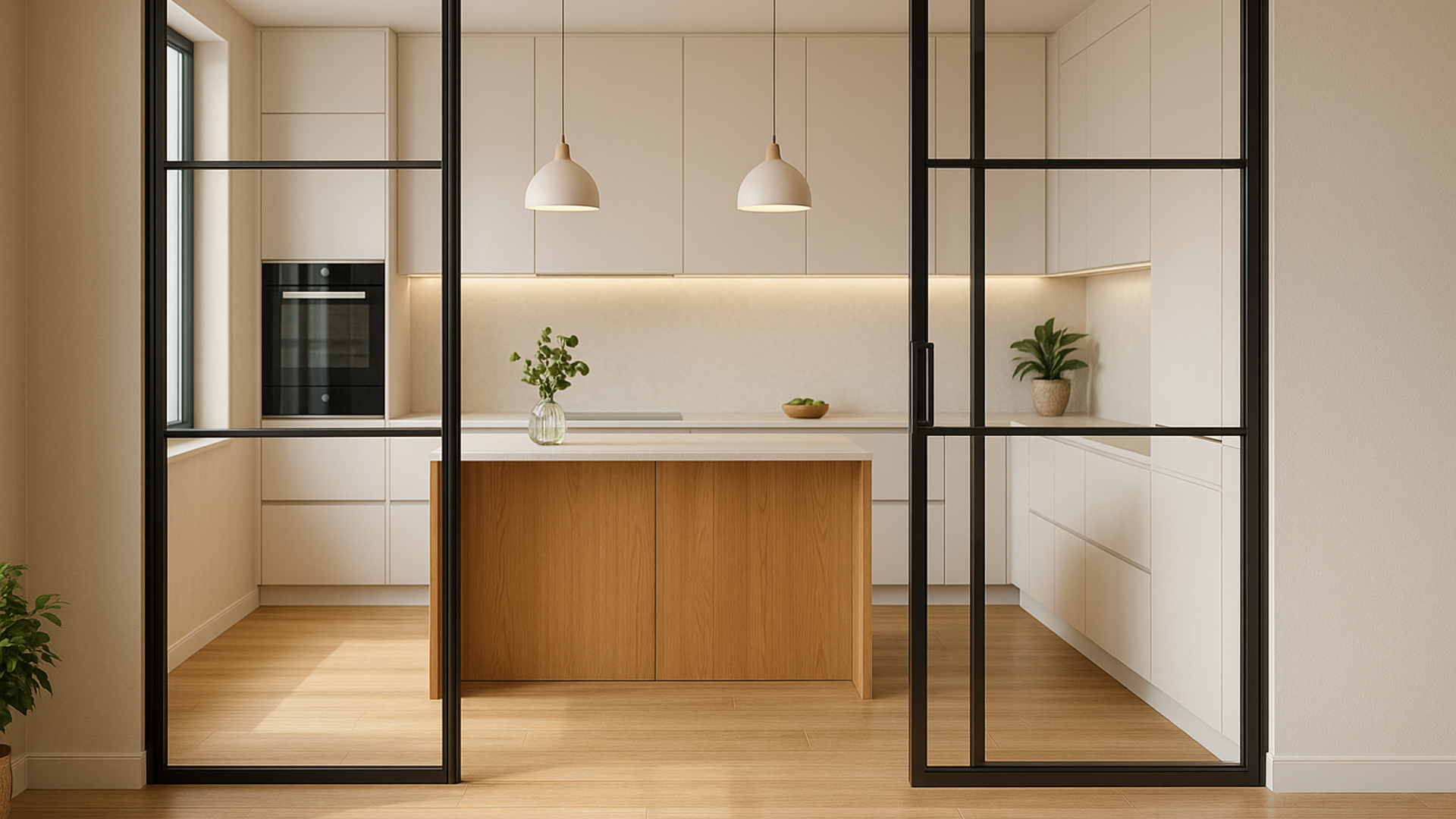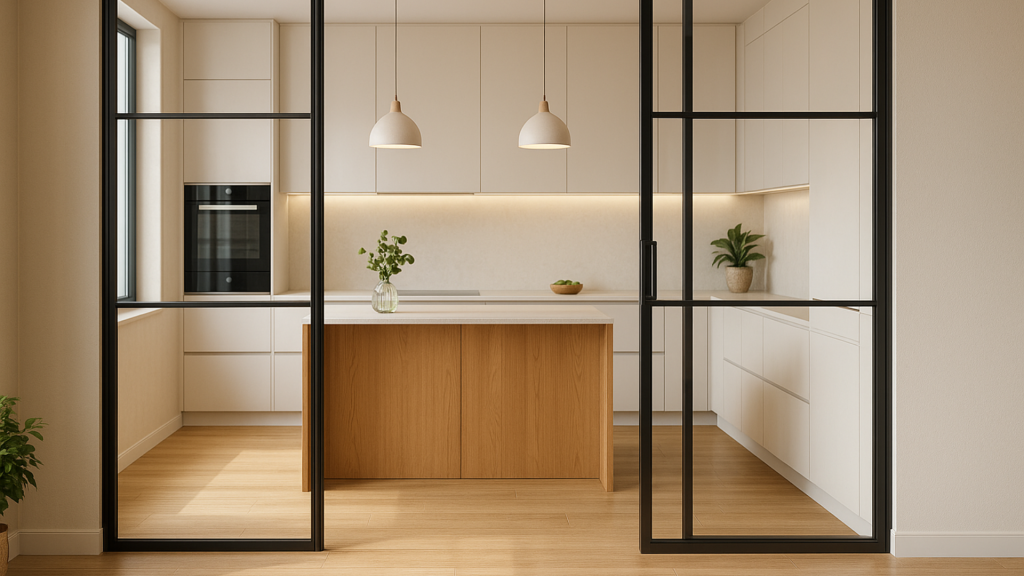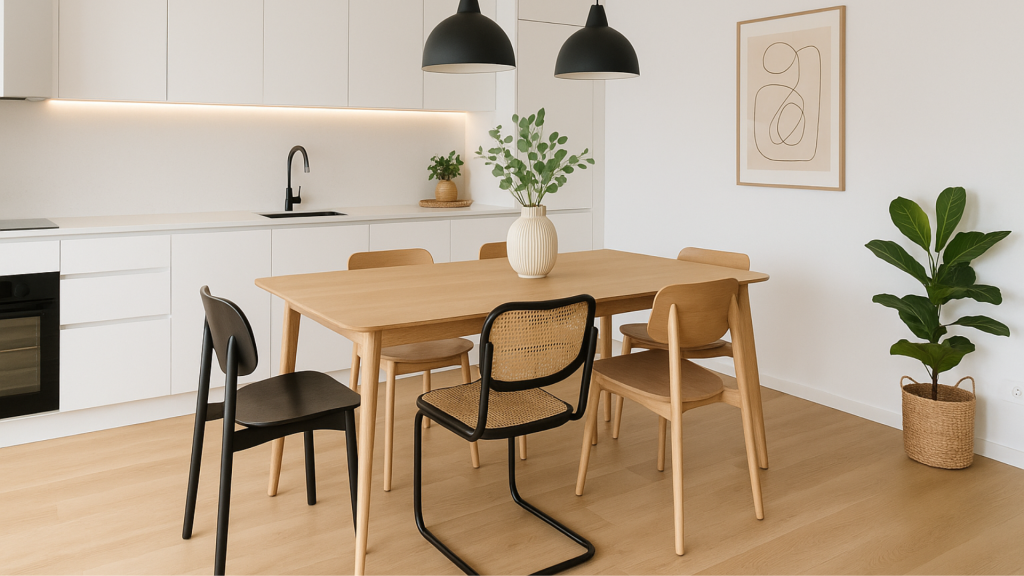
What is a glass kitchen and why is it a trend?
As interior designers, we know that the "open kitchen" is not always synonymous with comfort. That's why in recent years a solution that balances aesthetics and functionality has gained momentum: the glass kitchen. In this article we are going to explain, in detail and without beating about the bush, exactly what it is and why it is so fashionable. We will also take a look at guide prices, recommended materials and common mistakes to avoid.
Because yes: a kitchen glazed to the living room can multiply the light, add visual metres and control noise and odours... as long as it is designed judiciously.
Advantages of glazed kitchens
When we talk about glazed kitchens, we are referring to an interior enclosure of fixed and/or hinged glass that visually separates the kitchen area from the rest of the home, usually from the living/dining room. This system can be resolved with fixed panels, with a single or double-leaf glazed door, or with mixed systems that combine upper/lower fixed panels and hinged panels.
However, it is important to distinguish real benefits from unrealistic expectations:
- Light and spaciousnessGlass allows natural light to flow between rooms, visually amplifying the space. On deep floors or with a single window front, the change is noticeable.
- Acoustic order100%: reduces the noise level of hoods, dishwashers and conversation in the kitchen compared to an open space 100%.
- Odour controlVery effective if we want to let the light through but not the smell of food.
- Aesthetic continuityThe enclosure can become a design element that dialogues with the woodwork, flooring, lighting and furniture in the living room.
Kitchen glazed to the living room: when it pays off and when it doesn't
The glazed kitchen to the living room shines especially in medium-sized urban dwellings, elongated floor plans and renovations where we are looking for openness without sacrificing comfort. It pays off when:
- We need carry light to inland areas.
- We cook every day and we want to contain odours and splashes.
- We are looking for sense of continuity between kitchen and living room, but with a clean transition.
It might not be the best option if:
- The kitchen is extremely cramped and circulation is compromised.
- There is traces of moisture or condensation unresolved problems in the kitchen. First we renovate and ventilate, then we glaze.
- It is intended to Completely hide the kitchen. For this purpose, opaque systems, movable or panelled screens work best.
That said, the 80% is often a solid solution if you choose the right type of leaf, profiles and glass.

Glass door in the kitchen
The heart of the system is the door. And here it is important to decide wisely between several alternatives:
Glazed hinged door in the kitchen
- Isolationexcellent when executed with a perimeter frame and joints quality.
- Ergonomicsrequires an opening radius, but offers wide clearance and solid locking.
- AestheticsFrom the industrial look (black profile) to thin lacquered frames or minimalist solutions.
Professional recommendation: if sound insulation is a priority, the framed casement is, as a rule, the first choice.
Glazed pivot door in the kitchen
- Smooth opening and contemporary aesthetics.
- Sealinglower than that of a framed casement; improved by weatherstripping y magnetic closures.
- Usespectacular in generous spaces or showrooms; in compact dwellings, we would choose it for design, not for insulation.
Acrylic kitchen profiles
- Black lacquered aluminiumThe trend is still strong, but it is not the only one. Lacquered in sand, greige or white tones, they achieve a light aesthetic.
- Lacquered or brass-plated steelA more premium and resistant spot, ideal for high traffic projects.
- Woodprovides warmth, but needs careful sealing.
- Minimal all-glassalmost invisible profiling; beautiful, but requires high-end fittings.
Common mistakes in glazed kitchens
Measures without criteria
- Leaves that are too narrow or too high and visually "flex". We recommend analysing the modulation of furniture, ceilings and openings to form a harmonious grid.
- Heights that cut skirting boards or mouldings without trim. Best align with lintels, false ceilings or furniture lines.
Oversized or poorly resolved profiles
- Very thick profiles are "heavy" in small rooms. We are committed to slender sections with guaranteed rigidity.
- Lack of jointsIf the aim is to insulate, the construction detail is everything.
Insufficient ventilation and extraction
A glassed-in kitchen is no substitute for a bell with a good perimeter capture and a correct cross ventilation. Let us plan both elements from the outset.
Frequently asked questions about glazed kitchens
Does a sliding glass door provide the same insulation as a hinged door?
Other things being equal, the casement with frame and gaskets seals better. Sliders can be brought very close together if they incorporate lower guide, weatherstripping and a good pressure locking.
Which glass do we recommend for a glazed kitchen door?
For doors and passageways, laminate for safety and better acoustics. In fixed panels, tempered or laminated depending on format and regulations; if there is acoustic priority, acoustic laminate.
How do we prevent the glazed kitchen from fogging up?
With ventilation adequate, bell and control of thermal bridges. In specific cases, a anti-fogging treatment can help.
Will black profiling go out of fashion?
It doesn't seem short term, but if you want timelessness, go for fine frames in soft tones (white, greige, sand) and let the glass take centre stage in your glazed kitchen.
What they say about us
Publicado enTrustindex verifica que la fuente original de la reseña sea Google. me recomendaron Tarraula, una inmobiliaria para la decoración de un apartamento que había comprado en Javea. Al principio tienes miedo si te van a acertar los gustos, vas con muchas inseguridades, pero la verdad que fueron muy amables y prudentes a la hora de indicarte, me deje aconsejar por Cristina y no podemos estar mas agradecidos, el apartamento a quedado de revista ESPECTACULAR, tanto interior como exterior la mesa y las sillas de jardín, todo el que entra en el apartamento se queda encantado. Si volviese a realizar otro proyecto no dudaría en volverlos a llamar. Muchas, muchas Gracias a todo el equipo. Esperanza y VicentePublicado enTrustindex verifica que la fuente original de la reseña sea Google. Quedé muy contento con la decoración de mi casa, son muy profesionales, atentos y puntuales en todo. Tienen mucha variedad y te asesoran muy bien. Estuve en varias tiendas de la zona y nada que ver, totalmente recomendable.Publicado enTrustindex verifica que la fuente original de la reseña sea Google. Cristina and her team are a pleasure to work with. From just an initial meeting Cristina understood how we wanted to furnish our new home and came up with lots of ideas that suited our taste perfectly. She is very creative and spotted opportunities that we would never have seen. She has an amazing attention to detail. The furnishings are excellent quality but the team are always open to suggesting alternatives to fit with a given budget.Publicado enTrustindex verifica que la fuente original de la reseña sea Google. Wir haben Cristina, ihr Team und ihre Firma Tarraula aufgrund der Empfehlung unseres Bauträgers kennengelernt, als wir 2021 angefangen haben ein Haus in Javea zu bauen. Sie und Elisa standen uns von Anfang an zur Seite um unser neues Heim zu gestalten. Es zeichnet Cristina aus, dass sie genau zuhört und so ein Gespür dafür bekommt wie man sein Haus einrichten möchte. Auf Grundlage dieser Gespräche erstellt sie verschiedene Alternativen zu den unterschiedlichen Räumen die es zu möblieren gilt. Gemeinsam entscheidet man sich dann für die beste Idee. Cristina ist jederzeit offen für Anregungen die man selber einbringt. Das Handling, die Lieferung und der Aufbau der Möbel und der Dekoration nach der Planungsphase ist professionell und punktgenau. Alle Mitarbeiter sind freundlich und führen die Arbeiten sehr gut aus. Alles in allem eine großartige Erfahrung mit der wir so nicht gerechnet hatten. Unser Haus ist exakt so geworden wie wir es uns immer erträumt hatten. Vielen Dank an Cristina, Elisa und alle im Team.Publicado enTrustindex verifica que la fuente original de la reseña sea Google. Todo lo que hago en casa es siempre con Tarraula. Cristina siempre nos da las mejores soluciones y más creativas, tiene un gusto exquisito y estamos súper contentos con sus propuestas de decoración. Muchas gracias.Publicado enTrustindex verifica que la fuente original de la reseña sea Google. Botiga 100% recomanable. Un tracte increïble, s'adapten al teu estil i mobles de molta qualitat. Hem quedat molt contents amb el resultat i el servici. Repetirem.



